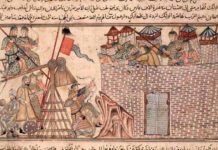The first war of the 20th Century resulted in a stronger Japan, revolution in Tsarist Russia, and United States efforts to create an Asian balance of power.
Korean independence was a casualty of the Russo-Japanese War of 1904-1905. Japanese occupation would continue until the end of World War II in 1945 and serve as an object lesson to anyone who doubted that the start of the twentieth century heralded an entirely new century identified with the most horrific wars in human history. In November 1905, the Koreans still looked to the United States to assist in their efforts against Japanese conquest. According to the New York Times, however, these assumptions were based on “false hopes.” (December 3, 1905)
General Causes of the Russo-Japanese War
The Russo-Japanese War began with the surprise attack against the Russian naval flotilla at Port Arthur on January 27, 1904. Japanese forces subsequently overwhelmed the poorly trained Russian troops, ultimately destroying a second Russian fleet on May 14, 1905 at the Battle of Tsushima. For the first time since imperialist western forces had begun the carving up of Asian spheres of influence, an Asian people had masterfully and soundly defeated a European power.
Russia, led by the weak Tsar Nicholas II, needed a war to instill patriotic feelings among an increasingly restless and revolutionary-minded population. The millions of peasants would follow the Tsar’s summons as if it were an order from God, but the same was not true of the more literate urban populations. Foreign adventures, especially those resulting in easy victories, diverted the curious away from radical ideologies. But, as historian Virginia Cowles wrote, “As usual everyone thought Russia would win, and as usual everything went wrong.”
Japan also had reasons to believe that war would change perceptions of the empire of the sun. Japan had modernized rapidly since western warships had forced the “opening” of the nation in 1853-1854. By 1873, Japan invaded Taiwan but received little for her efforts. As the United States entered the race for imperialist control of Asian spheres of influence, notably with the acquisition of the Philippines after the Spanish-American War, Japan looked for an alliance, supporting the Open Door policy in China. Her principal ally in the region was Great Britain.
Roosevelt’s Asian Balance of Power
The President most interested in Japan and her future intentions was Theodore Roosevelt. Roosevelt preferred Japan over Russia during the 1904-1905 war, privately endorsing Japanese war aims and post-war claims even as he attempted to portray himself as an honest broker during peace negotiations at Portsmouth in New England. Japan’s taking of independent Korea as a protectorate was an immediate effect of this brokered peace; it would lead to continued Japanese aggressions in Manchuria and China, paving the path toward an inevitable conflict with the United States in 1941.
Another effect of the Russo-Japanese War was the influence of Japanese sea power. The Battle of Tsushima resulted in the obliteration of Tsar Nicholas’ Baltic fleet, which had sailed around Africa to confront the Japanese. Historians argue that the Russian fleet was unequal to the newer Japanese ships under the skillful leadership of Admiral Togo. Togo had already incapacitated the Russian Pacific flotilla at Port Arthur and at Vladivostok.
While that was true, of greater importance was the perception: Europeans could not imagine that a western power would be susceptible to Asian victory on the scale of Tsushima. It was the same faulty perceptions that allowed the Japanese to overwhelm Singapore in early 1942 and prove the superiority of air power over sea power at the start of the Pacific War.
Long Term Results of the Peace Treaty
Although Teddy Roosevelt worked toward an Asian balance of power in the aftermath, according to historian Warren Zimmermann, “…he wanted Japan to succeed but not too overwhelmingly.” Part of the balance of power involved the sacrifice of an independent Korea – despite earlier American assurances to the contrary, in return for a Japanese pledge to recognize U.S. hegemony in the Philippines. This quid pro quo was consolidated through Roosevelt’s envoy, Secretary of War William Taft, during his visit to Tokyo in 1905.
Tsar Nicholas II refused, however, to pay any indemnity to the Japanese. This refusal became a source of antagonism in Japan and almost provoked a resumption of hostilities. The legacy of Russian defeat, however, was swiftly turned into internal revolution in what some historians regard as the first phase of the Russian Revolutionary movement that eventually ended Romanov rule in March 1917.
The first modern war of the twentieth century featured all of the players that would, to some degree, play decisive roles in the ensuing world wars. In terms of Asia, Japan was the long term victor, demonstrating the invincibility of the west and devoting the national psyche toward further regional conquests. The United States played a double game, clandestinely supporting Japan over Russia in the hopes of maintaining the China Open Door while preserving her own colonial outposts.
Myths and Realities of the First 20th Century War
As in the Crimean War and the Russo-Turkish War, the Tsar’s military was out-maneuvered and ill-prepared, this time by the better equipped Japanese. Despite these realities, the myth of the “Russian steamroller” would prevail into 1914. Having learned from these successes, including the surprise attack at Port Arthur, Japan would use similar techniques at Pearl Harbor in Hawaii in 1941 and Singapore in 1942. Korea remained occupied by Japan until 1945, at which time it was divided between the democratic South and the Communist North. It remains so to this day.








